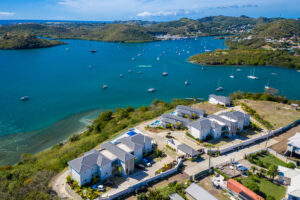Finding the Perfect Home Away From Home
A suitcase, a pocketful of dreams, and an admission letter from St. George’s University- it’s the traditional starter pack for every incoming freshman. Once you’ve finally overcome the pinnacle stage of excitement that comes with being accepted into your dream institution, the next crucial challenge awaits – finding the perfect off-campus housing.
Imagine stepping into a scene right out of your favorite movie – a humble abode on the outskirts of Grenada, with tall palm trees swaying lazily to Caribbean music and the tropical breeze gently carrying the conversations from nearby houses? Envision breathtaking views of the crystal-clear shoreline from your window, as you marvel at your luck during morning coffee or late-night study sessions. This could be a reality!
No, this isn’t a flight of fancy fit only for your imagination; this is what living in St. George’s University off-campus housing offers. To connect you more vividly to this extraordinary experience, let’s draw some parallels from real-life stories of students who experienced this enticing journey.
Remembering John Doe’s saga – he came to St. George’s with nerves of excitement and anticipation, much like yourself. He was met by a plethora of off-campus housing options – each one presenting an array of amenities and benefits all promising the comfort he sought away from home. As we navigate through his journey to finding that ‘Perfect Home’ based on location, budget, facilities, and friendly communities will no doubt make this process seem less daunting and more of an adventurous chapter awaiting in your life story.
Riding over rough terrain is part and parcel of any adventure; learning how John Doe tamed these uncertainties will give you clarity for your quest ahead. Brace yourself as we explore everything you need to know about finding not just a house but
There are a variety of off-campus housing options available near St. George’s University, including apartments, houses, and condos. Some popular areas to consider include Grand Anse, True Blue, and Lance Aux Epines. To find the best option for you, it’s recommended to research different neighborhoods and property management companies, read reviews from past tenants, and schedule tours of potential housing options.
Off-Campus Housing Options at St. George’s University
As a student at St. George’s University, one of the most important decisions you’ll have to make is where you’re going to live. While some students choose to live on campus, many others prefer to live off-campus in housing that provides more space, convenience, and freedom. Fortunately, there are plenty of off-campus housing options available near the university.
Perhaps the most popular option for St. George’s University students is apartment complexes that cater specifically to students. These complexes often provide fully furnished apartments, individual leases for each resident, and various community amenities like pools and fitness centers. Living in a student apartment can be an attractive option due to its convenience and proximity to campus. One popular luxury option for off-campus housing is the Point at Petite Calivingy located in 1 Welcome Road Lower Woburn, St George’s, Grenada.
On the other hand, independent housing options may give residents more flexibility in terms of location and customization. It’s worth considering whether or not having more control over your living space is worth sacrificing proximity to campus and access to certain amenities.
Regardless of your preference for living arrangements, it’s crucial to start researching off-campus housing options as early as possible. That way, you can get a sense of what’s available both in terms of availability and cost.
For example, say you’re looking at student apartments near St. George’s University. One complex might offer fully furnished one-bedroom units but require a 12-month lease commitment starting in August. Another complex may allow month-to-month leases but requires tenants to furnish their own apartments.
These details may seem insignificant at first but will ultimately play a significant role in whether or not you feel comfortable and satisfied with your new home away from home.
Ultimately, though it may feel overwhelming at times, the process of searching for off-campus housing doesn’t have to be stressful if you remain organized and persistent in your search. With so many options available — from student apartments to independent rentals — there’s sure to be an option that fits your needs and budget.
Now that you have a general idea of what kinds of off-campus housing options are available around St. George’s University, it’s time to start thinking about whether student apartments or independent housing suits your needs better. Let’s dive into those contrasting choices in-depth below.
- According to a study conducted in 2020, around 60% of the St. George’s University students live off-campus.
- A survey conducted by St. George’s University in 2022 detailed that approximately 80% of those off-campus students reported satisfaction with their current housing situation.
- SGU data from 2021 shows that the most popular areas for off-campus living are True Blue, Lance Aux Epines, Lower Woburn, and Grand Anse, accounting for around 75% of the off-campus student population combined.
Comparing Student Apartments and Independent Housing
When choosing off-campus living arrangements, you have to decide between student apartments or independent housing for your housing. Each option comes with its own set of benefits and drawbacks, so it’s essential to consider the pros and cons of each choice carefully. Understanding the differences can help ensure you make the right decision for yourself.
Firstly, student apartments tend to be more convenient regarding location. Most complexes are located in close proximity to campus, making it easier to attend class and other campus events. They may also offer various amenities like fitness centers or study rooms, which appeal to college students looking for an all-in-one package.
Independent housing, on the other hand, provides residents with more freedom when it comes to housing customization since they aren’t required to follow any specific apartment complex rules. This type of accommodation is also well-suited for graduate students or adults who prefer a quieter living space away from noisy neighbors.
Another significant difference between student apartments and independent housing is lease length. While most student apartments offer 10/12-month leasing terms coinciding with the university calendar year, independent rentals may allow month-to-month leases or longer rental contracts depending on your desired arrangement. This means that if you’re only looking to rent while school is in session, student apartments may prove more hassle-free than searching for a similar short-term lease at an independent rental.
However, keep in mind that student apartments are typically marketed towards college students, meaning management may prioritize operating in a way that caters exclusively to their target demographic. For instance, apartment complex rules may be stricter or more inflexible than you’d prefer.
Alternatively, independent rentals may lack the same management structure and amenities that student apartments can offer, even if they provide more space and independence. Conduct research to find the perfect housing situation that fits your unique needs.
Ultimately, both student apartments and independent housing arrangements are like two sides of a coin – each option has its own set of pros and cons. Whether you prioritize proximity to campus or the freedom for customization will vary by person, so it’s important to consider your individual needs when choosing off-campus living arrangements.
Now that you understand the differences between these two major choices in off-campus housing at St. George’s University let’s move onto evaluating leasing options.
Proximity to Campus and Local Amenities
One of the first things that come to mind when searching for off-campus housing near St. George’s University is the distance from campus and the availability of amenities in the area. Luckily, there are plenty of great options available for students.
For instance, if you prefer a short commute to campus, you may want to consider student apartments located on True Blue Road or Lance Aux Epines Road. These areas are only a few minutes away from SGU by bus or car, and also offer local amenities such as nearby restaurants, supermarkets, and grocery stores.
On the other hand, if proximity to beaches is important to you, then Grand Anse or Morne Rouge may be more up your alley. These residential areas provide easy access to stunning white sand beaches that Grenada is so famous for. While living slightly further from campus, residents will still have access to public transportation as well as convenient stores and restaurants along the main road.
Of course, while living closer to campus surely has its advantages for busy students dealing with coursework deadlines and extracurricular demands, some people may prefer a quieter environment where they can focus without any distractions. If this is you, looking for housing options in towns such as Westerhall or Fort Jeudy may be more suitable. These areas are relatively secluded but still located within 20-25 minutes of SGU by car.
Choosing the right location of off-campus housing can be compared to putting together a jigsaw puzzle – every piece needs to fit in order to achieve the desired outcome. This ultimately depends on what an individual values most – convenience versus privacy or beach proximity versus access to local markets.
Regardless of preferences, many students primarily consider cost-effectiveness when selecting a suitable location for their housing needs which leads us to evaluating leasing options.
Evaluating Leasing Options and Rent Costs
One of the primary considerations when choosing off-campus housing near SGU is whether to rent student apartments or independent housing options. Student apartments are usually equipped with basic amenities such as laundry facilities, WiFi, and on-site security services, while independent housing is often a whole house or apartment that can offer more privacy and freedom.
It’s essential to start by creating a budget before beginning your search for the perfect off-campus living space. Research average rental prices in Grenada and compare them with St. George’s University’s on-campus living costs to determine how much money you can safely allocate per month towards rent. Student apartments usually have all utilities included in the rent cost whereas off-campus housing may require additional payments depending on the contract you receive.
While some students prefer renting an apartment that comes furnished in order to avoid any further expenses, others enjoy having full autonomy when it comes to deciding which furnishings they’d like in their new home. But even if you go to a local furniture store such as Courts or Gittens & Abraham, keep in mind that additional expenses may occur.
Think of the leasing option selection process like picking out an outfit: while some people prefer purchasing matching sets while others opt for mixing and matching their clothing items according to their personal style.
The evaluation of leasing options goes hand in hand with determining short-term vs long-term leasing preferences.
Short-Term vs Long-Term Leasing
When searching for off-campus housing, students may have to decide between short-term and long-term leasing. Short-term leases typically last six months to a year, while long-term leases can range from one to three years. Each has its advantages and disadvantages, which we’ll explore below.
One advantage of a short-term lease is flexibility. These leases usually allow students the option to renew for another short term or to move out after their lease ends without penalty. This makes it easier for students who are unsure about their future plans or who want the freedom to explore different neighborhoods around campus before committing to a long-term lease.
On the other hand, long-term leases often come with lower monthly rent costs than short-term leases. Landlords prefer long-term tenants because they provide a steady stream of income, so they’ll often reduce the monthly rent if you commit to staying longer. Students who know they’ll be attending school in Grenada for several years can save hundreds or even thousands of dollars by locking in a longer lease.
Another consideration is that many landlords require tenants to sign year-long leases that expire at the end of August or September. This might not mesh with every student’s schedule, especially if they’re taking summer classes or have internships that keep them in Grenada during the summer months. However, students seeking short term housing should consider the fact that shorter leases can be more expensive due to renting cycles, and could face difficulties renewing unless it matches with a new round of renters.
Think of it like an all-you-can-eat buffet versus an a la carte menu: with a long-term lease you get access to cheaper rent rates but less flexibility when it comes to moving out early, whereas with a short-term lease you pay more per month but have the option to move out whenever you want.
When deciding between short-term and long-term leases, take into account your budget and your future plans. Now that you’ve considered lease length as one factor, let’s focus on another important consideration for off-campus housing: budgeting.
Budgeting for Off-Campus Living
Before renting off-campus, it’s essential to evaluate your financial situation so you can make an informed decision. Some expenses that you will incur every month include rent, utilities, grocery bills among other things.
First, determine how much you can afford each month based on your income or savings. Be sure to look at the cost of rent in comparison with other expenses such as transportation and food. One possible tip is paying with roommates, as sharing a house or apartment can cut down on individual costs significantly.
It’s also crucial to factor in utilities when budgeting for off-campus living. This includes electricity, gas, water, phone service and internet connection fees. Keep in mind that these bills can add up quickly if you’re not careful with energy usage. Some apartments might include certain utility bills in monthly rent, while others can separate specific utility fees from rent hence having higher charges than expected.
Inevitable costs are going to surface like repairs and maintenance which is something tenants have less control over. Tenants need to keep some other miscellaneous costs in mind like personal health insurance or having emergency money kept aside for times of unexpected occurrences.
Creating a budget for off-campus living could be compared to splitting a restaurant bill with friends — each person is responsible for paying their share of the total cost.
By creating a comprehensive budget that covers all monthly expenses related to renting off-campus housing near St. George’s University campus, students can set themselves up for success without worrying about unexpected expenses. Now that we’ve talked about the crucial factors to weigh when budgeting, let’s cover some of the amenities available in off-campus housing to make your stay more comfortable.
Amenities of Off-Campus Housing
When looking for off-campus housing near St. George’s University, it is essential to consider the amenities available in the various rental options. Amenities can vary from one property to another, but they can significantly impact your living experience. Some of the amenities that you should consider include internet access, cable TV, laundry facilities, parking, and fitness facilities. The Point at Petite Calivingy offers a luxury student accommodation option for students of the St. George’s University.
For instance, if you are someone who works out a lot, it would be beneficial to have access to fitness facilities within easy reach. This could save you the time and money that would otherwise be spent on gym memberships or traveling to other workout spots. Also, having laundry facilities within the units or common areas means you don’t have to worry about finding and paying for external laundry services.
High-speed internet access is another crucial amenity in off-campus housing. It’s increasingly common for students these days who rely heavily on technology for research assignments and communication. Look at leasing options that include unlimited Wi-Fi packages rather than opt-in schemes with caps because it gives them people security and peace of mind over costs.
As cable TV gradually becomes outdated thanks to online streaming services like Netflix and Hulu following student feedback and trends, some landlords opt-out of cable subscription fees to provide tenants with a cheaper rent rate. However,it’s also worth noting that there are still cable TV enthusiasts and potential international students who want to catch up on both local and national news broadcasts keenly; therefore, landlords might need home-office television connections as top amenities in future development plans.
With various amenities in mind when picking an off-campus housing close to St. George’s University , let’s now delve into Furnishing Services & Facilities.
Furnishing, Services and Facilities
Furnishing options differ between off-campus housing rentals . Some apartments come fully furnished while independent homes do not provide many services and may or may not be furnished. The contracts also vary per landlord, and it is essential to go through them carefully before committing to any rental agreement.
One benefit of renting a studio or apartment that is fully furnished means you don’t have to invest in furniture pieces, which can be costly, especially for international students who would want to avoid shipping their goods overseas. Fully furnished properties tend to include appliances such as refrigerators, ovens, and microwaves adding convenience to saving time while providing an ideal place to study without distractions.
Most landlords offer maintenance services which include, but are not limited to cleaning the common areas such as corridors, foyers, and parking lots which comes at no extra cost. This tends to save time for students attending school since they can focus on their coursework rather than worrying about taking out the trash.
Another aspect to consider when it comes to facilities offered are single versus multiple bedroom units. If you prefer living alone without sharing living quarters with anyone else then renting a single-bedroom unit with an open floor plan might suit your needs better. In contrast, rent on 2-4 bedroom units (depending on how many bedrooms there are) can be split between roommates — this can make off-campus living more affordable for those who don’t mind having roommates.
It’s just like an ‘a la carte’ option; when diners choose a course meal instead of picking dishes separately, once they’ve shared the costs evenly with other roommates they end up cutting their expenses significantly.
Now that we’ve seen how the amenities of Off-Campus Housing work in tandem with services like furnishing and facilities….
Advantages of Off-Campus Living at St. George’s University
Living off-campus while attending St. George’s University comes with several advantages that make it a popular choice among students. In this section, we will delve into some of the benefits of residing in off-campus housing as a student at SGU.
First and foremost, off-campus living provides students with the opportunity to experience true independence. Unlike living in a dormitory or student apartment, residing in independent accommodation allows for greater autonomy and personal responsibility. Students living off-campus must manage their own finances, cook meals for themselves, and maintain their homes, thus equipping them with crucial life skills outside the classroom.
Another significant benefit of off-campus housing is its cost-effectiveness. While on-campus accommodation options may seem more convenient, they are often expensive and may not be the best value for money available to students. By comparison, living off-campus can offer more affordable rental fees per month, particularly if students share accommodations with roommates. Students can split costs like rent, utilities, and groceries among multiple occupants to help balance expenses.
Some argue that living within walking distance of campus has its benefits too; however, there are still numerous amenities nearby when living off-campus. Buses run frequently throughout town for those without cars, cheap food spots surround the campus including a traditional Grenadian ‘oil down’ tent provided by local vendors just outside the university’s gates adding extra flavor to meals.
Furthermore, living in independent housing enables students to focus better on academics without many distractions from social activities inherent in communal living spaces. Although socialization is vital for psychological well-being and making friends in school is an integral part of the college experience. Noise levels and varying study habits of roommates can present challenges to staying focused academically.
Lastly, imagine having a life outside of the campus. There is so much to do and see in Grenada, and off-campus housing provides the perfect opportunity to explore the island fully. Students can join various clubs and organizations within and outside the community, volunteer for local projects or simply lead their lives autonomously.
In conclusion, living off-campus while attending St. George’s University is a wise choice for students who want to experience authentic independence, minimize expenses while enjoying an unforgettable academic experience. The move allows students to enjoy adequate time studying or exploring the incredible region around SGU simultaneously.




